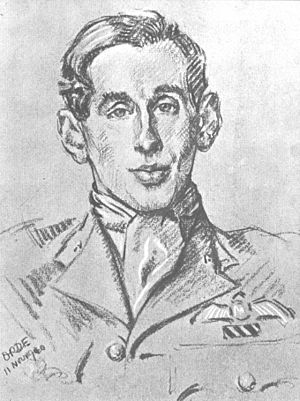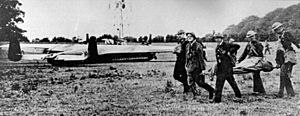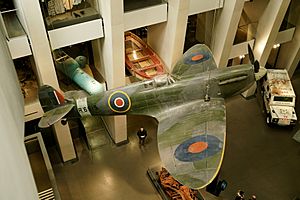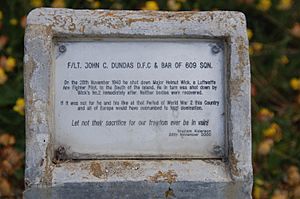John Dundas (RAF officer) facts for kids
Quick facts for kids
John Charles Dundas
|
|
|---|---|

Portrait of John Dundas, by Cuthbert Orde
|
|
| Nickname(s) | Dogs |
| Born | 19 August 1915 West Yorkshire, England |
| Died | 28 November 1940 (aged 25) English Channel, off the Isle of Wight, England |
| Allegiance | United Kingdom |
| Service/ |
Royal Air Force |
| Years of service | 1938–1940 |
| Rank | Flight lieutenant |
| Unit | No. 609 Squadron RAF |
| Battles/wars | Second World War
|
| Awards | Distinguished Flying Cross & Bar |
| Relations | Sir Hugh Dundas (brother) |
John Charles Dundas was a brave fighter pilot in the Royal Air Force during World War II. He was known as a 'flying ace' because he shot down 12 enemy aircraft.
John was born in West Yorkshire, England, in 1915. He was a very smart student and went to Oxford University. After college, he worked as a journalist for a newspaper. In 1938, he decided to join the Royal Auxiliary Air Force (RAuxAF). He became a pilot officer in No. 609 Squadron and trained to fly.
In May 1940, his squadron fought in the Battle of France. John got his first two victories there. He stayed with his squadron through the tough Battle of Britain, shooting down nine German planes. For his bravery and 10 victories, he received the Distinguished Flying Cross (DFC) on October 9. By his last battle, he had shot down 12 enemy aircraft. On November 28, 1940, John Dundas is thought to have shot down Helmut Wick. Wick was the top German ace at the time. Moments later, John's plane was also shot down into the sea. Both pilots disappeared and were never found.
Contents
Early Life and Training
John Charles Dundas was born in West Yorkshire in 1915. He came from important families in the area.
John was a very bright student. At 12, he won a scholarship to Stowe School. At 17, he won another scholarship to Christ Church, Oxford. He earned a top degree in history. He then studied in Paris and Heidelberg.
After university, John became a journalist for the Yorkshire Post newspaper. One of his co-workers remembered him as a popular but messy person. He often had ink-stained hands and spilled drinks.
In 1938, his newspaper sent him to Czechoslovakia and Rome to report on important meetings. In July 1938, at age 23, John joined No. 609 Squadron RAF. This squadron was part of the Royal Auxiliary Air Force. At first, they flew Hawker Hind bombers.
John was well-liked by his fellow pilots. He often flew his commanding officer's plane. However, on June 18, 1939, his plane crashed during takeoff. The engine failed, and the plane ended up in a nearby garden. Luckily, John was not hurt.
Later, the squadron changed from bombers to fighter aircraft. In August 1939, they received the famous Supermarine Spitfire planes. John's younger brother, Hugh, was also a fighter pilot. Hugh was injured in 1940 but recovered and became a high-ranking officer. He survived the war.
World War II Battles
Battle of France Experience
In January 1940, John was promoted to flying officer. His squadron, 609, was stationed on the south coast of England. In May 1940, they helped protect ships during the Dunkirk evacuation. This was when many soldiers were rescued from France.
On May 30, John flew his first patrol. The next day, his squadron flew towards Dunkirk. They fought German planes for the first time. John shot down a Heinkel He 111 bomber and a Dornier Do 17 bomber. He did not score any more victories during the Battle of France.
On June 11, John was one of nine Spitfire pilots who escorted Winston Churchill to France. Churchill was trying to convince the French to keep fighting.
Fighting in the Battle of Britain
Over the next few weeks, 609 Squadron moved to RAF Middle Wallop. From here, John got his first victory of the Battle of Britain. On July 13, John led a patrol over a convoy of ships. He attacked Messerschmitt Bf 110s. John shot down one Bf 110. The damaged plane and its pilot made it back to France. Later in July, John had a close call during a night flight. His wing hit an artillery gun while landing, but he was not hurt.
John fought many battles with German planes in the following days. He noticed the fights were getting more intense. He started writing the squadron's war diary in August. He wrote that the "Nazi blitz" (German air attacks) began on August 8.
On August 11, John flew his Spitfire R6769. He led his section out to sea near the Isle of Wight. John and two other Spitfires lost contact with their squadron. He saw German Bf 110s and Bf 109s above them. John attacked alone. He shot down a Bf 110. His plane was hit by German gunners, but he was okay.
On August 12, John fought more Bf 109s and Bf 110s in the same area. He shot down another Bf 110. He damaged another but had to leave the fight because he was low on fuel and ammunition. This fifth victory made him a 'flying ace'.
The German air force launched a huge attack on August 13, called Adlertag ("Eagle Day"). At 3:30 PM, 609 Squadron was sent into action. John spotted Junkers Ju 87 Stuka dive-bombers below him. He attacked and shot down one Ju 87. He damaged another before his plane was hit. He had to land his plane without engine power at RAF Warmwell. The German unit he attacked lost many planes.
The next day, August 14, John damaged a Bf 110. He then damaged a Do 17 bomber. On his way back to base, John saw a Heinkel He 111 bomber. He attacked it, causing it to crash near his airfield.
John did not claim another victory until September 15, known as Battle of Britain Day. In the morning, he damaged a Do 17 bomber. Later, he shared a Do 17 victory with his wingmen. On September 24, he damaged a Do 17 and destroyed a Bf 110. The next day, he claimed a Do 17 destroyed near Bristol. On September 26, he shot down a Bf 109 and damaged another Do 17. The following day, he claimed a Bf 110 destroyed near Bristol.
Eleven days later, John claimed a probable victory against a Bf 110. This was after a battle with German planes near RAF Warmwell. A cannon round exploded in his cockpit, hitting his leg. But he flew again the next day. The Spitfire John flew that day, R6915, is now in the Imperial War Museum. By October 9, 1940, he had 10 victories and was awarded the Distinguished Flying Cross.
A week later, on October 15, 1940, John destroyed another Bf 110 over Christchurch, Dorset. He was chased by two Bf 109s but got away. His victory was the 99th for 609 Squadron.
Channel Front and Final Battle
By this time, John was the highest-scoring pilot in his unit. His friends and fellow pilots liked him very much. He shared his flying experience with younger pilots. John was the only original pilot from 609 Squadron still flying.
On November 27, a German Ju 88 bomber was reported near Southampton. John asked to go after it but was told no. He then asked his squadron leader for permission to take his section on a practice flight. John chased the German plane over the Isle of Wight. He got close and fired his guns. The Ju 88's engine caught fire and it dived out of control. John was credited with a probable victory.
The next day, November 28, was very busy for 609 Squadron. They were sent out several times to fight Bf 109s. The last call came around 3:30 PM. John was flying his Spitfire X4586. Two squadrons, 152 and 609, met Bf 109s from Jagdgeschwader 2. These German planes were led by Helmut Wick, Germany's most successful ace at that time.
Minutes after the fight started, John's voice was heard shouting, "I've finished a 109—Whoopee!" His squadron leader congratulated him. But then, nothing more was heard from John or his wingman, Pilot Officer Paul A. Baillon.
It is believed that Wick shot down Baillon. Baillon managed to parachute out, but he was never found. Wick then flew into John's path. John fired a short burst, hitting Wick's Bf 109. Wick was seen parachuting out of his plane, but he was not rescued and his body was never found. Moments later, John was likely shot down by Wick's wingman, Rudolf Pflanz. Pflanz claimed a victory and saw the Spitfire crash into the sea with the pilot still inside. Like Wick, John's body was never found.
On December 24, 1940, John Dundas was given a second DFC award after his death. The award was announced on January 7, 1941. The award said John had continued to fight the enemy with great success. He had destroyed at least 12 aircraft and damaged many more. It said he showed a "magnificent fighting spirit" that inspired others.
Memorials and Preserved Aircraft
Since John Dundas has no known grave, he is remembered at the Air Forces Memorial in Runnymede, England.
There is also a small memorial to John on a cliff-top path near Freshwater Bay on the Isle of Wight. This is close to where his last battle happened. It was put there in November 2000, 60 years after his death.
One of the planes John Dundas flew, Supermarine Spitfire number R6915, still exists. It is kept at the Imperial War Museum in London. In this plane, he claimed a probable kill over a Bf 110 on October 7, 1940.
John Dundas' Victories
Here is a list of the enemy planes John Dundas shot down or damaged between May 31 and November 28, 1940.
| Chronicle of aerial victories | |||||||||
|---|---|---|---|---|---|---|---|---|---|
| Claim No. | Date | Kills | Notes | ||||||
| 1–2. | 31 May 1940 | Heinkel He 111 destroyed Dornier Do 17 destroyed |
|||||||
| 3. | 13 July 1940 | Messerschmitt Bf 110 destroyed | Claimed south of Portland. The German pilot was wounded but crashed in France. | ||||||
| 4. | 11 August 1940 | Messerschmitt Bf 110 destroyed | Claimed south west of Swanage. The German pilot was killed. | ||||||
| 5. | 12 August 1940 | Messerschmitt Bf 110 destroyed Messerschmitt Bf 110 damaged |
Claimed over Isle of Wight. This made him a 'flying ace'. | ||||||
| 6. | 13 August 1940 | Junkers Ju 87 destroyed Junkers Ju 87 damaged |
Claimed over Lyme Bay. | ||||||
| 14 August 1940 | Dornier Do 17 probable shared Heinkel He 111. |
The shared victory was with Pilot Officer D.M. Cook. The German bomber had several crew members killed or wounded. | |||||||
| . | 25 August 1940 | Messerschmitt Bf 110 probable | |||||||
| . | 15 September 1940 | Third share Dornier Do 17 Dornier Do 17 damaged |
The Do 17 was found with a flamethrower device in its tail. | ||||||
| 7. | 24 September 1940 | Messerschmitt Bf 110 destroyed Dornier Do 17 damaged |
Claimed at 4:30 PM. | ||||||
| 8. | 25 September 1940 | Dornier Do 17 destroyed | Claimed destroyed south of Bristol. | ||||||
| 9. | 26 September 1940 | Messerschmitt Bf 109 destroyed Dornier Do 17 damaged |
Claimed over Southampton. | ||||||
| 10. | 27 September 1940 | Messerschmitt Bf 110 destroyed | Claimed in the Weymouth–Swanage area. Several other Bf 110s were shot down in this battle. | ||||||
| . | 7 October 1940 | Messerschmitt Bf 110 probable | John was hit in the leg during this battle. | ||||||
| 11. | 15 October 1940 | Messerschmitt Bf 110 destroyed | Claimed over Christchurch. | ||||||
| . | 27 November 1940 | Junkers Ju 88 probable | |||||||
| 12. | 28 November 1940 | Messerschmitt Bf 109 destroyed | This was the plane of German ace Helmut Wick, who was killed in action. | ||||||
See also
- List of people who disappeared mysteriously at sea




